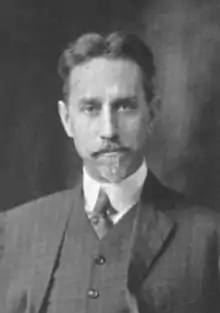George W. Conable
George Willard Conable (1866-1933), AIA, was an American architect practicing in New York City in the early to mid 20th century specializing in churches.
George W. Conable | |
|---|---|
 | |
| Born | George Willard Conable October 4, 1866 Cortland, New York |
| Died | Tampa, Florida January 2, 1933 (aged 66) |
| Nationality | USA |
| Education | |
| Occupation | Architect |
Biogrpahy
George W. Conable was born in Cortland, New York on October 4, 1866. He graduated from Cortland State Normal School in 1886, and from Cornell University in 1890.[1]
In 1905 he was an assistant to noted architect Ernest Flagg and prepared plans and working drawings for the Singer Building.[2] His office was at 15 Myrtle Avenue, Jamaica, Queens in the 1908, 46 West 24th Street in 1918. He entered into a brief partnership with Hobart Upjohn as the firm of Upjohn & Conable of 96 Fifth Avenue, New York, in 1911.[3] He is best known as the architect of Holy Trinity Lutheran Church (New York City) (1908) and Messiah Evangelical Lutheran Church (1926)[3]
He died in Tampa, Florida on January 2, 1933.[4]
Works as George W. Conable
- 1908: German Evangelical Lutheran Church of 164 West 100th Street, 90 East Amsterdam Ave and 100th Street, a two-storey brick and stone church and parsonage for $50,000[3]
- 1916: Queensboro Hospital for Contagious Diseases, Parsons Boulevard and Grand Central Parkway in Jamaica, Queens.[5]
- 1918: 179-181 West Houston Street, single-storey office, for Congress Warehouse & Forwarding Co.; J. L Wolff, Pres of 474 West Broadway, for $5,000[3]
- 1919: 179-83 West Houston Street, single-storey brick garage, for Congress Warehouse & Forwarding Co.; J. L Wolff, Pres of 474 West Broadway, for $5,000[3]
- 1926: Messiah Evangelical Lutheran Church, 198-200 Sherman Avenue, two-story brick school and chapel for $40,000[3]
- 1926: Trinity Lutheran Church (Queens, New York), overseer for architect John William Cresswell Corbusier, listed on the National Register of Historic Places in 2008.[6]
- 1928: Jamaica Chamber of Commerce Building,[2] listed on the National Register of Historic Places in 1983.[6]
Works as Upjohn & Conable
- 1909: Rye Town Park-Bathing Complex and Oakland Beach, added to the National Register of Historic Places in 2003.[6]
- 1911: a brick and stone fence rear of brick residence, 546 West 153rd Street for Washington Heights Evangelical Lutheran Church of 546 West 153rd Street for $250[3]
| Wikimedia Commons has media related to George W. Conable. |
References
- The National Cyclopaedia of American Biography. XVI. James T. White & Company. 1918. p. 367. Retrieved December 12, 2020 – via Google Books.
- Larry E. Gobrecht (April 1983). "National Register of Historic Places Registration: Jamaica Chamber of Commerce Building". New York State Office of Parks, Recreation and Historic Preservation. Archived from the original on May 23, 2013. Retrieved January 16, 2011.
- Office for Metropolitan History, "Manhattan NB Database 1900-1986," (Accessed 25 Dec 2010).
- "George W. Conable Dies in Hospital Here". Tampa Bay Times. January 3, 1933. p. 2. Retrieved December 12, 2020 – via Newspapers.com.
- "Contagious Disease Hospital Dedicated". Brooklyn Standard Union. Fultonhistory.com. June 29, 1916. p. 5. Retrieved August 4, 2017.
- "National Register Information System". National Register of Historic Places. National Park Service. March 13, 2009.